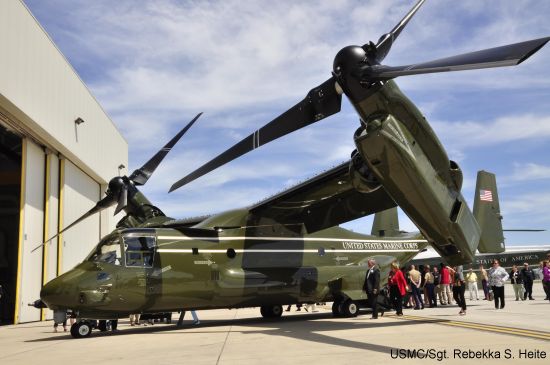
US Marine Corps, May 04, 2013 - MARINE CORPS BASE QUANTICO by Sgt. Rebekka S. Heite - One week after six MV-22B Ospreys successfully flew the longest and largest transatlantic flight of any Osprey squadron to date, Marine Helicopter Squadron One hosted a MV-22B Introduction Ceremony at the HMX-1 hangar on May 4, 2013.
The ceremony marked the beginning of HMX-1’s transition from CH-46E Sea Knights to MV-22B Ospreys for green-side and presidential support flights: carrying White House staff members and press, said Col. John Faircloth, HMX-1 commanding officer and a Grady, Ala., native.
Though the aircraft will begin supporting the troops of Officer Candidates School and The Basic School immediately, filling the presidential support role is scheduled to begin late this year or early next, he added.
“The Marine Corps is transitioning its medium platform helicopters, so it’s a natural transition,” Faircloth said. “It’s a tremendous airframe and a game-changing machine.”
The game-changing machine adds its own capabilities.
“The Osprey is a wonderful addition in speed and range,” said Col. Kevin Wild, incoming commanding officer, HMX-1. “It takes a CH-46 a couple of hours to fly to New York, it takes an Osprey one hour. That means we can make more trips in one day.”
“The Osprey can fly higher, making it less vulnerable to weather,” Wild said. “It can get over or around bad weather better than the 46.”
The HMX-1 lead transition officer for the MV-22 agreed with Wild.
“The Osprey can fly higher, faster and is a more comfortable ride,” said Maj. John Sarno, HMX-1 lead transition officer for the MV-22. “It’s an additional capability. Not better, different. She has her own capabilities.”
“It is quiet in airplane-mode, but even in conversion-mode it’s quieter than a (CH-53 ‘Super Stallion’),” said Sarno.
A HMX-1 Osprey pilot added that its lift capabilities will also help HMX-1 complete its mission.
“The Osprey adds flexibility and capability in speed and lift,” added Capt. Peter D. Benning, operations schedule writer, Operations, HMX-1, and MV-22 pilot. “It can carry more, go faster and fly higher than the 46.”
“It won’t change the mission, but it will change the way it’s done,” Benning, a Sonora, Calif., native said.
Maj. Gen. Andrew W. O’Donnell Jr., deputy commander, United States Forces, Japan, a guest speaker during the ceremony also had much to say about the MV-22B.
“The operational record of the MV-22 is above all,” said O’Donnell. “We and our colleagues in the U.S. Air Force's Special Operations Command have flown more than 170,000 flight hours. The aircraft is very good and very, very safe.”
“It’s changing how we do business,” he added. A second squadron of MV-22Bs is scheduled to arrive in Japan this summer.
Currently, the squadron has only one Osprey, which is identical to those used by Marines in the fleet other than its paint job, but it expects to have 12 by next summer, said Sarno.
Faircloth is scheduled to relinquish command to Wild during a change of command ceremony, June 20, 2013.
The ceremony marked the beginning of HMX-1’s transition from CH-46E Sea Knights to MV-22B Ospreys for green-side and presidential support flights: carrying White House staff members and press, said Col. John Faircloth, HMX-1 commanding officer and a Grady, Ala., native.
Though the aircraft will begin supporting the troops of Officer Candidates School and The Basic School immediately, filling the presidential support role is scheduled to begin late this year or early next, he added.
“The Marine Corps is transitioning its medium platform helicopters, so it’s a natural transition,” Faircloth said. “It’s a tremendous airframe and a game-changing machine.”
The game-changing machine adds its own capabilities.
“The Osprey is a wonderful addition in speed and range,” said Col. Kevin Wild, incoming commanding officer, HMX-1. “It takes a CH-46 a couple of hours to fly to New York, it takes an Osprey one hour. That means we can make more trips in one day.”
“The Osprey can fly higher, making it less vulnerable to weather,” Wild said. “It can get over or around bad weather better than the 46.”
The HMX-1 lead transition officer for the MV-22 agreed with Wild.
“The Osprey can fly higher, faster and is a more comfortable ride,” said Maj. John Sarno, HMX-1 lead transition officer for the MV-22. “It’s an additional capability. Not better, different. She has her own capabilities.”
“It is quiet in airplane-mode, but even in conversion-mode it’s quieter than a (CH-53 ‘Super Stallion’),” said Sarno.
A HMX-1 Osprey pilot added that its lift capabilities will also help HMX-1 complete its mission.
“The Osprey adds flexibility and capability in speed and lift,” added Capt. Peter D. Benning, operations schedule writer, Operations, HMX-1, and MV-22 pilot. “It can carry more, go faster and fly higher than the 46.”
“It won’t change the mission, but it will change the way it’s done,” Benning, a Sonora, Calif., native said.
Maj. Gen. Andrew W. O’Donnell Jr., deputy commander, United States Forces, Japan, a guest speaker during the ceremony also had much to say about the MV-22B.
“The operational record of the MV-22 is above all,” said O’Donnell. “We and our colleagues in the U.S. Air Force's Special Operations Command have flown more than 170,000 flight hours. The aircraft is very good and very, very safe.”
“It’s changing how we do business,” he added. A second squadron of MV-22Bs is scheduled to arrive in Japan this summer.
Currently, the squadron has only one Osprey, which is identical to those used by Marines in the fleet other than its paint job, but it expects to have 12 by next summer, said Sarno.
Faircloth is scheduled to relinquish command to Wild during a change of command ceremony, June 20, 2013.
MV-22B Osprey 168280 ( US Marine Corps )
See also |
HMX-1
MV-22 in
First Maintenance Service for VIP Osprey




